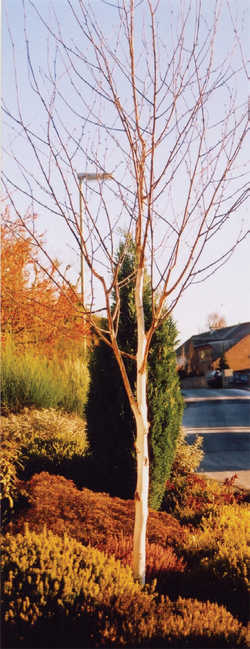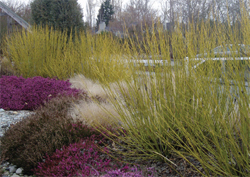|
These are usually our coldest two months of the year, so a lot of us will be gardening from books in front of the fi re, but despite the weather there is still plenty to do in the garden. Outdoor plants can be classifi ed in several ways: trees, shrubs, conifers and climbers Therefore, any disturbance or damage to the roots of evergreens in January and February Deciduous plants, however, are dormant in terms of growth and movement of water through the stems. This makes it a good time of year to perform any major surgery or even to move plants. In terms of surgery (or pruning as we are dealing with plants!), trees and shrubs can be pruned back a lot harder than at any other time of year. Fruit trees are prime candidates for working on in January - it is almost as if the cold works as an anaesthetic to them. Before pruning any fruit trees, stand back and assess what wants doing. Is the tree too big for you to manage and needs reducing in size? Is it OK in size, but lots of branches are crossing and shading fruit production? Is the tree old, gnarled, diseased causing it to lose vigour? Has it stopped producing fruit or even begun to produce a decent crop in alternate years (biennial bearing)? If the tree is too big or losing vigour it is worth pruning quite hard all over the tree, cutting back to a manageable shape and cutting out thin and weak growth. The tree will look quite odd after this, just the main branches with no ‘fl uffy’ stuff to make it look natural, but do not worry, this will cause the tree to be shocked into producing strong new growth. If the tree has lots of crossing branches, or has very dense growth, it is worth thinning it out, this will help air and light get into the middle of the tree and help the fruit to ripen. Once a tree has been thinned out, the branches should almost be like an upside down cone, with nothing in the middle and the main branches coming from the stem at between 45 and 60°. Moving deciduous trees and shrubs should also be done at this time of year. One of my friends has a lovely magnolia which is right in the way of where he wants to park his car, so instead of ripping it out, we will help him to dig around the plant, lifting out as much soil and root as we can, and then putting it straight into a prepared hole in a new location. This can also be useful for plants that have grown to big, become too congested or even if you just want to change your garden around. Herbaceous plants can also be worked on now, for instance Hostas, Dicentras and Geraniums can be lifted with a fork, split apart using a spade and then replanted, giving you two or three new vigorous plants instead of BOSWORTH’S Nurseries & Garden Centre OPEN: Mon-Sat: 9am - 6pm All Credit Cards Accepted NOT JUST A GARDEN CENTRE |
|
Upcoming Events
-
Mayor’s 90s Night
Saturday 20th April, 19:30 -
Shamblers Walk
Sunday 21st April, 13:30 -
Spring Bridge Drive
Tuesday 23rd April, 10:00 -
East Northants Association of The N...
Tuesday 23rd April, 19:30 -
Quiz Night
Tuesday 23rd April, 19:30



